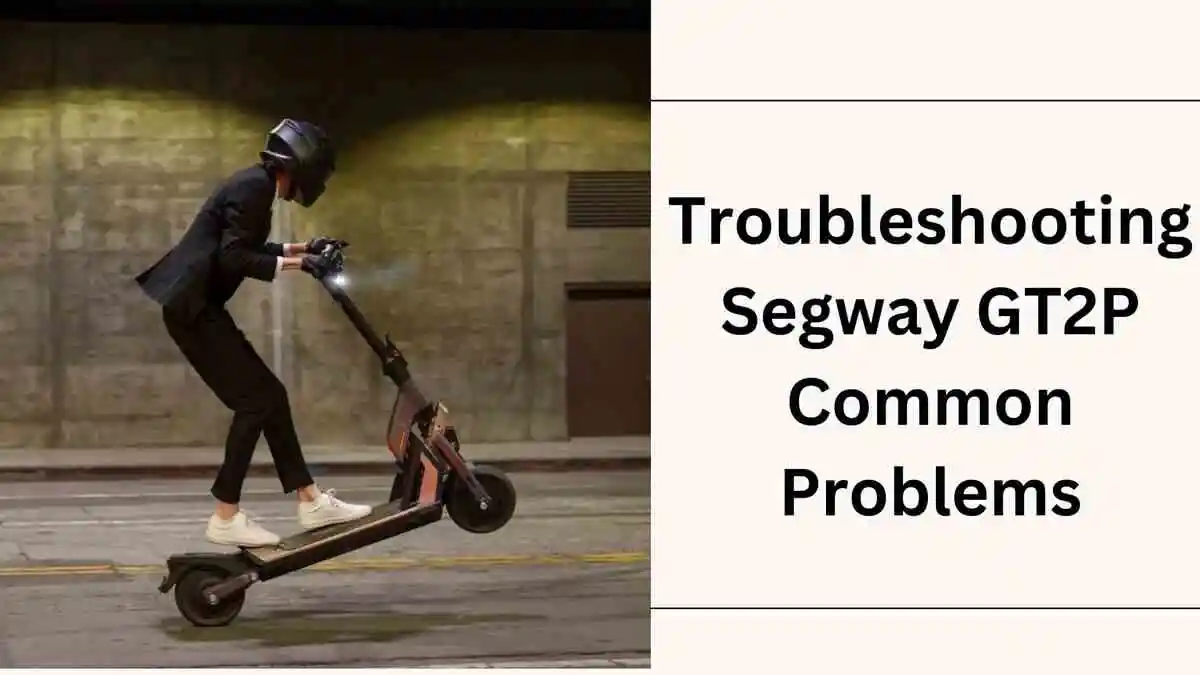Welcome to our exploration of the Segway GT2P and the challenges that have emerged in its journey through the realm of personal transportation. As enthusiasts and riders have eagerly embraced the promise of an innovative and efficient mode of travel, it’s essential to delve into the nuanced landscape of the Segway GT2P problems.
From technical glitches to user experiences, we aim to navigate the intricacies of this cutting-edge device, shedding light on both its merits and the hurdles it faces. Join us on this journey as we dissect the issues, explore potential solutions, and provide insights into the evolving world of personal mobility
First Thing First:
Initial Check: If you’ve recently got the Segway GT2P electric scooter and it’s not working well because of the company’s fault, it’s a good idea to quickly ask the person you bought it from for your money back or a new one. If it’s been too long for a refund, you can try to use the warranty to get it fixed.
Next Level Check: For people who have used the scooter for at least 35 months (sometimes 30 months), using the warranty for repairs becomes a good choice. This repair time takes about one month but adds at least two more months to your scooter’s life, almost until the warranty ends. This situation shows how these devices are made to keep companies going.
So, if you’ve been using your scooter actively for 28 months, now might be a good time to think about getting a new affordable electric scooter. Whether you want a light e-scooter or one with big wheels, upgrading could be a solution if the other ideas don’t work for you.
Important Reminder: Another thing people are dealing with is keeping electric scooters in apartments. If you’re curious, there’s a lot of info about storing electric scooters in apartments. Also, electric scooter problems happen a lot in cities, and you can find more details about these challenges in cities.

Segway GT2P Problems:
1. Not Charging:
Note: The battery used in segaway ninebot gt2p is lithium ion battery, which has its own number of cycles (How many times a battery can be charged). In case of segaway there are 500 cycles of charging from fully discharged state to recharge. How many times you recharge the longevity of battery decreases. So use for 2 days with one charge to keep the battery going untill the life of scooter ends.
However if you are facing problem of segaway ninebot gt2p battery not charging or the battery not able to keep a charge well because it’s been used a lot and has regular wear. For this you can do following things.
Fixing Issues:
- Double-check that the charger is connected correctly to both the scooter and the power outlet.
- Look for any obvious damage or rust on the battery connectors and clean them if necessary.
- If the battery still doesn’t work well, think about getting a new one from a Segway dealer who is authorized to sell them.
There is also an issue in which segaway ninebot beeps when on charge so to fix this click here.
2. Not Turning ON:
If you are facing segway gt2p not turning on issue then there is a detailed article we ahave already described the reasons and fixes for this problem, so click here to read about fixes when scooter won’t turn on.
However if you are facing the problem of segway gt2p not turning on when plugged
3. Unresponsive LCD Display:
The screen on your scooter might stop working or have issues because of problems with the software or if it got physically damaged. You can also follow the steps below to try to fix it, but if you need more detailed instructions, you can click here for more information on fixing the display.
Fixing Issues:
- Turn off your scooter and then turn it back on to see if the display starts working again.
- If the problem keeps happening, try resetting the display settings back to the way they were when you first got it.
- If the display still doesn’t work, get in touch with Segway customer support for more help or to ask for a new display.
4. Uneven Brake Performance:
Brakes not working evenly can happen if the brake pads are worn out, not adjusted properly, or if there’s air in the brake lines.
Fixing Issues:
- Check the brake pads for wear and put in new ones if they’re too worn out.
- Adjust the brake cable as per the manufacturer’s instructions to make sure both wheels brake evenly.
- Remove any air bubbles from the brake lines by bleeding them; this will make the brakes work better.
5. Scooter Pulling to One Side:
If your Segway GT2P pulls to one side while you’re riding, it might be because the wheels are not aligned properly or there’s uneven tire pressure.
Fixing Issues:
- Make sure both wheels have the right amount of air by checking and adjusting their tire pressure to the recommended levels.
- Look at how the front wheel and handlebars are aligned; if they’re not straight, adjust them.
- If the problem doesn’t go away, go to a Segway service center that’s authorized to get a professional check and alignment.
6. Motor Overheating:
Using the scooter a lot or riding it in really hot or extreme weather can make the motor get too hot.
Fixing Issues:
- Give the motor a break by turning off the scooter and letting it cool down.
- Try not to ride the scooter for a long time in really hot weather, especially if you’re going fast.
- Keep the motor and the area around it clean so it can get enough air to cool down properly.
7. Sudden Loss of Power:
If your scooter suddenly loses power, it might be because of a bad connection, low battery, or issues with the motor.
Fixing Issues:
With these fixes also see a detailed information in which electric scooter is on but not moving. With that you should also see fixes if your electric scooter turns off while you riding on it.
- Look at all the connections and make sure they’re tightly connected.
- Check how much charge is left in the battery and recharge it if needed.
- If the battery is full but the problem continues, check the motor and controller for any damage or problems.
8. Brake Noise:
If your brakes make noise on and off, it could be because the brake pads are getting worn out, or there’s dirt and debris between the brake parts.
Fixing Issues:
- Look at the brake pads and put in new ones if they’re worn.
- Clean all the brake parts, like calipers and rotors, to get rid of any dirt making noise.
- If the noise keeps happening, think about using brake grease or lubricant on the parts to make them slide better and reduce noise.
9. Uneven Tire Wear:
Uneven tire wear can happen if the tire pressure is wrong, the wheels aren’t aligned, or if you ride aggressively.
Fixing Issues:
- Keep an eye on your tire pressure and make sure it’s what the manufacturer suggests.
- Check your tires for signs that they’re not aligned, and adjust the front wheel and handlebars if necessary. Try to ride smoothly to avoid extra wear.
10. Bluetooth Connectivity Problems:
Problems with Bluetooth connection can happen because of interference or issues with the software.
Fixing Issues:
- Make sure your Segway GT2P is close enough to the device it’s connecting to, without anything in the way causing problems.
- Turn off both the scooter and the device it’s connecting to, and then turn them back on to reset the Bluetooth connection.
- If the problem doesn’t go away, see if there are any updates for the scooter’s and the device’s software, and install them if there are.
11. Handlebar Vibrations:
If you feel vibrations in the handlebars, it could be because of bumpy roads, loose parts, or worn-out grips.
Fixing Issues:
- Look at the handlebar grips, and if they’re worn out, put in new ones.
- Make sure everything on the handlebars, like grips and controls, is tightened up to lessen vibrations.
- Think about adding materials or accessories to the handlebars that absorb vibrations for a more comfortable ride.
12. Unresponsive Acceleration:
If your scooter isn’t speeding up when you want it to, the problem might be with the throttle, the controller, or the motor.
Fixing Issues:
- Look at the throttle for any damage or things in the way, and clean it if needed.
- Check the controller and the wiring for any signs of damage, making sure all the connections are tight.
- If the problem keeps happening, test the motor on its own to figure out if the issue is with the motor or the controller.
13. Excessive Wobbling:
If your scooter wobbles a lot, it could be because the weight isn’t balanced, the wheels aren’t aligned, or some parts are loose.
Fixing Issues:
- Make sure the weight on your scooter is spread out evenly, and don’t carry heavy things on just one side.
- Check if the front wheel and handlebars are in line, and adjust them if they’re not.
- Tighten up all the bolts and screws on your scooter to get rid of any possible reasons for wobbling.
14. Delayed Braking:
If your scooter takes a while to stop when you hit the brakes, it might be because there’s air in the brake lines, the brake pads are worn out, or the brakes aren’t set up right.
Fixing Issues:
- Get the air out of the brake lines by bleeding them to make the brakes work better.
- Check the brake pads for wear and put in new ones if they’re too worn out.
- Adjust how tight the brake cable is following what the manufacturer says so your brakes respond faster and better.
15. Strange Motor Noises:
If your motor is making strange sounds, it could mean there are parts that are loose, the bearings are worn out, or there’s something wrong with the motor.
Fixing Issues:
- Look at the motor and the parts around it for any screws or bolts that might be loose, and tighten them up.
- If the noise doesn’t go away, check the motor bearings for wear and put in new ones if needed.
- Test the motor by itself to figure out exactly where the problem is coming from.
16. Incorrect Speedometer Readings:
If your speedometer is giving you the wrong speed, it might be because of calibration issues or problems with the sensor.
Fixing Issues:
- Look at the sensor and make sure it’s aligned right and not covered in dirt or debris.
- Calibrate the speedometer according to what the manufacturer says for more accurate readings.
- If the problem doesn’t go away, consider getting a new speedometer or getting in touch with Segway customer support.
17. Uneven Suspension Performance:
If your suspension doesn’t feel even, it might be because the settings are off or some parts are worn out.
Fixing Issues:
- Change the suspension settings to make sure it works the same all the time.
- Look at the suspension parts to see if they’re worn or damaged, and put in new ones if needed.
- If the problem keeps happening, get help from a Segway service center that’s authorized to fix it.
18. Squeaky Handlebars:
If your handlebars make a squeaky noise, it might be because some parts are loose or need lubrication.
Fixing Issues:
- Make sure everything on the handlebars, like grips, stem, and controls, is tightened up.
- Put a little bit of lubricant on the handlebar parts to reduce friction and stop the squeaking.
- If the noise doesn’t go away, see if there are any damaged parts and replace them if necessary.
19. Unresponsive Power Button:
If the power button isn’t working, there might be a problem with the button itself or the electrical connection.
Fixing Issues:
- Look for any damage or dirt around the power button and clean it if needed.
- Check the electrical connections connected to the power button to make sure they’re tight.
- If the power button still doesn’t work, get in touch with Segway customer support or ask for a new button.
20. Cruise Control Inconsistency:
If your cruise control doesn’t work right all the time, it might be because of software issues or problems with the sensors.
Fixing Issues:
- Check if there’s a firmware update for your scooter and install it to see if that helps.
- Calibrate the cruise control sensors as per the manufacturer’s instructions.
- If the problem keeps happening, turn off cruise control until you can fix it.
21. Unresponsive Brake Lights:
If your brake lights aren’t working, it could be because of a problem with the brake light switch or issues with the wiring.
Fixing Issues:
- Look at the brake light switch to make sure it’s working correctly and makes contact when you use the brakes.
- Check the wiring for any signs of damage or loose connections, and fix or replace as necessary.
- If the brake lights still don’t work, think about getting professional help or going to a Segway service center.
22. Excessive Handlebar Vibration:
If your handlebars vibrate a lot, it could be because the wheels are unbalanced, parts are loose, or the grips are worn out.
Fixing Issues:
With these fixes you should also have to check the height of handlabars and adjust it.
- See if the wheels are balanced and balance them if needed.
- Tighten up everything on the handlebars, like the stem and grips, to make the vibrations less.
- If the grips are worn out, put in new ones that can absorb vibrations better.
23. Abnormal Motor Noises:
If you hear strange noises from the motor, it could mean there are issues with the motor itself, loose parts, or worn-out bearings.
Fixing Issues:
- Look at the motor and nearby components for any screws or bolts that might be loose, and tighten them.
- If the noises don’t go away, check the motor bearings for wear and put in new ones if needed.
- Test the motor by itself to figure out if the problem is with the motor or other components.
24. Frequent Tire Punctures:
If your tires keep getting punctured, it might be because of rough terrain or running over sharp objects.
Fixing Issues:
- Look at your tires and take out any foreign objects stuck in the tread carefully.
- Think about getting puncture-resistant tires for more protection.
- Change how you ride to avoid bumpy surfaces or places with things that could puncture your tires.
25. Incorrect Battery Level Reading:
If your scooter is showing the wrong battery level, it might be because of a problem with the battery sensor or software issues.
Fixing Issues:
- Calibrate the battery following what the manufacturer says to do.
- See if there are any software updates for your scooter’s display system and install them if there are.
- If the problem keeps happening, get the battery sensor checked and replaced by a Segway service center that’s authorized if needed.
26. Acceleration Delay:
If your scooter takes time to speed up, it might be because of problems with the throttle response, issues with the controller, or motor problems.
Fixing Issues:
With these fixes you also have to read more on it, click here to see fixes for electric scooter not accelerating.
- Look at the throttle for any physical damage or things in the way, and clean it if needed.
- Check the controller and the wiring for any signs of damage, making sure all the connections are tight.
- If the problem keeps happening, test the motor on its own to figure out if the issue is with the motor or the controller.
Conclusion:
In summary, troubleshooting and addressing issues with the Segway GT2P are crucial for a reliable riding experience. From battery and motor concerns to connectivity and vibrations, this guide offers practical solutions. Regular maintenance and timely interventions enhance longevity.
Understanding root causes empowers users to prevent future complications. As personal mobility evolves, staying informed is key to fully enjoying the innovative Segway electric scooter.



